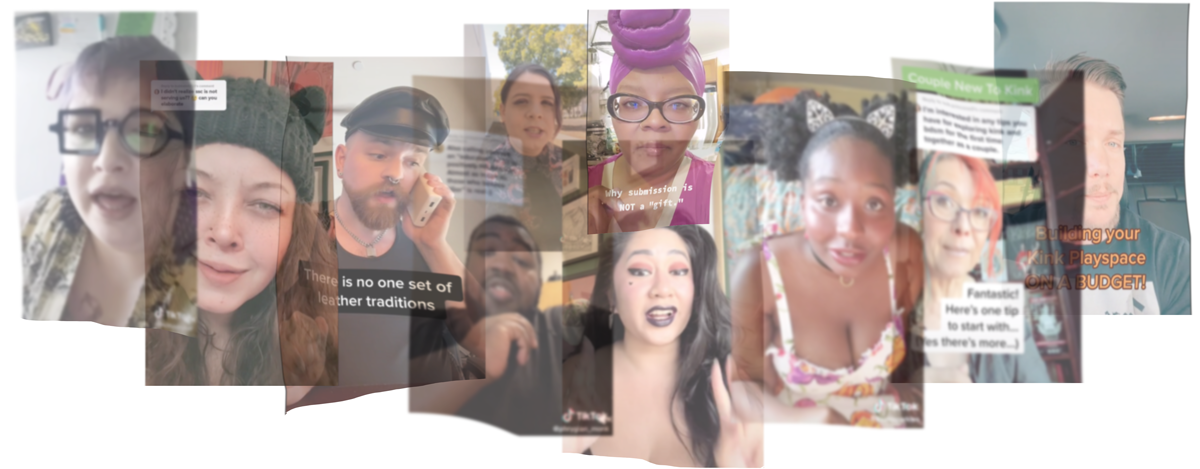I turned 18 the year Friendster was released into the world. It was the early aughts, and this was one of the first social media sites to gain widespread popularity. I had come of age in AOL chatrooms, writing about my experiences and finding community on LiveJournal and (don’t laugh) DarkPoetry. Through the connections I made in these cybernetworks, I ended up having the confidence to move from one coast to the other, landing in San Francisco ready to reinvent myself for the first time as an adult.
Social media, in the beginning, felt to me more like a space where I could let my freak flag fly in a land where it didn’t feel out of place. Sneaking Nancy Friday’s “Women on Top” from my parent’s bedroom had shown me that I had fantasies about bondage, dominance, and submission. I read every book I could find on the topic like I was starving. While people joked about AOL chatrooms being a place for people to have cybersex, it was also where I got to chatting with kinky people in the UK, hearing about events they went to, workshops they ran, and websites like Castle Realm that had information on how to engage in power dynamics safely. There were plenty of places to indulge in the fantasy of BDSM, but UK BDSM on AOL was the first place to ground me on how these things worked in real life while balancing university, jobs, kids. Later, it became Informed Consent, which was centered around the UK community. With its forums and event boards, it was a localized version of what the most well-known BDSM site, Fetlife, is today.
Here in the Bay Area, I didn’t find that kind of community on Friendster or Myspace, but I did find it on a website that was similarly localized but not kink specific, a site called Tribe. Within the site, I managed to find local groups centered around popular BDSM events, various kinky interests, and sure, even something weird and niche like cooking tips. I appreciated having a space like Tribe, which didn’t relegate conversations about sexuality to some secret backroom, but let it be out in the open alongside other topics such as American Sign Language or feminist theory. It was a unique time on the internet, and I felt really free to be a multifaceted person, not ignoring any part of who I was, but embracing all of it, publicly and proudly.
This is when censorship began to make an impact on kink’s freedom of expression on social media. In 2005, Tribe implemented a new TOS in the wake of 2257 expanded regulations. 2257 requires website owners to have physical copies of records proving anyone depicted in “visual content” that could be deemed “sexually explicit” is over 18. Tribe also included an easily abused flagging system that allowed users to tag other people’s posts as “obscene” and gated the community so you could only view content if logged in. Many users left Tribe in droves, forging communities instead on social media sites like Tumblr, Google Groups, Facebook, and Twitter. Sites that were specific to alternative sexualities like Alt.com or Collarme/Collarspace had a momentary surge in popularity, but people missed having a space that at least had a marketplace of ideas next to the meat market.
Fetlife appeared in 2008 to fill the void and offer an attractive option – social media centered around kink. Initially, it was just another kink site, passed around by word of mouth, jokingly calling itself “Facebook for the kinky community”. But as websites like Craigslist, Tumblr, Blogger, and Instagram increasingly banned content to satisfy conservative banks and skittish website owners worried about legal ramifications, plus sites like Google and Facebook began enforcing “real name” policies that reduced the safety of anonymity, Fetlife became the best-known refuge for kinksters seeking community. Focusing more on discussions and events than on matchmaking, Fetlife soon had an effective monopoly on altsex social media; sex workers, BDSM practitioners, sex educators, and erotica writers were being banished from other social media networks if they didn’t play by ever-changing rules. Fetlife became a sanctuary of sorts.
One of the double-edged swords of anonymity is that the cloak that protects careful users from losing their job or their children for talking about being kinky online also protects people acting in bad faith. In the wake of Fetlife’s policy of not making criminal accusations against another in a public forum (which effectively prevented communities from communicating online about abusers), many people began to trickle back to more mainstream social media while figuring out where to go next. Then came FOSTA/SESTA, a pair of bills that made website publishers responsible for content on their platforms It caused many sites to push back even harder against content that could be deemed “adult” and a lot of content on these mainstream sites was again lost. Even so, the desire for community is stronger than the fear of censorship. Eenclaves of sex-positivity defiantly formed, even in the face of hostility on platforms like Facebook, using creative language to wriggle around being flagged.







